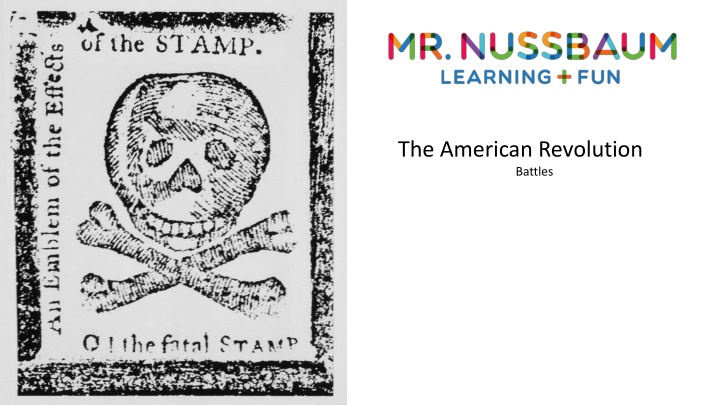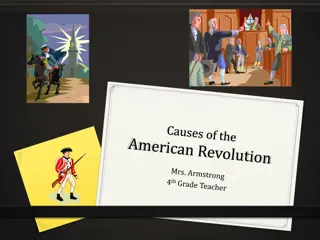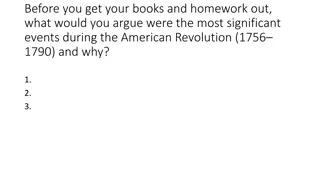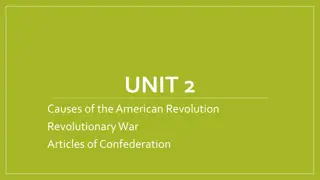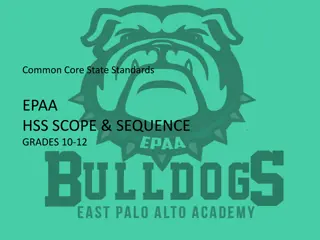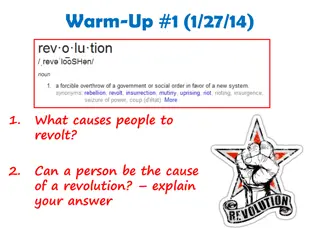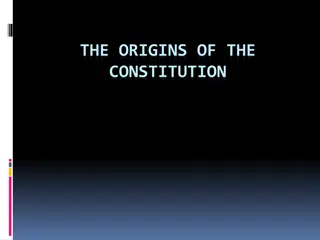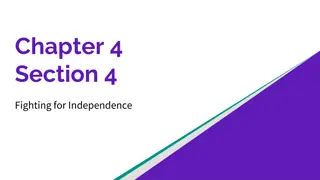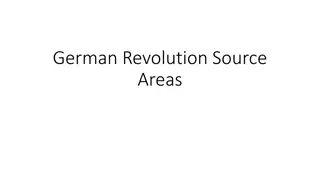The American Revolution Battles: Key Events and Battles
Discover key events and battles of the American Revolution, including the Battles of Lexington and Concord, the Battle of Bunker Hill, and the strategic shifts in 1776. Learn about the pivotal moments that shaped the course of the Revolutionary War with images and descriptions.
Download Presentation

Please find below an Image/Link to download the presentation.
The content on the website is provided AS IS for your information and personal use only. It may not be sold, licensed, or shared on other websites without obtaining consent from the author.If you encounter any issues during the download, it is possible that the publisher has removed the file from their server.
You are allowed to download the files provided on this website for personal or commercial use, subject to the condition that they are used lawfully. All files are the property of their respective owners.
The content on the website is provided AS IS for your information and personal use only. It may not be sold, licensed, or shared on other websites without obtaining consent from the author.
E N D
Presentation Transcript
The American Revolution Battles
April 19, 1775 The First Battle of the Revolutionary War is known as the Battles of Lexington and Concord. The first shot fired is sometimes referred to as the shot heard round the world.
April 19, 1775 It occurred in Massachusetts as British Redcoats marched from Boston, through Lexington, to Concord, to destroy military supplies and weapons stockpiled by the Massachusetts militia. Before the Redcoats reached Lexington however
April 18, 1775 The Sons of Liberty had received intelligence warning of the British march and Paul Revere and others rode through town around midnight shouting the regulars are coming! Two lanterns lit in Boston s Old North church signaled that the British were arriving by sea. Thus, the famous warning, one if by land, two if by sea.
April 19, 1775 The first shots were fired at Lexington. No one knows if the British or Patriots fired it. In the gun battle that followed, however, eight minutemen were killed. The Redcoats marched on to Concord where they destroyed a cache of Patriot weapons.
April 19, 1775 In Concord, and during the British march back to Boston, minutemen fired at the Redcoats from behind trees, under bridges and from behind large rocks. By the time the Redcoats made it back to Boston, 73 had been killed and nearly 200 injured. The war had begun!
Battle of Bunker Hill June 17, 1775 In the second major battle of the war, British forces scored a pyrrhic victory over the Patriots. The battle was waged for control of the hills overlooking Boston. In the Battle, the British suffered over 1,000 casualties. A pyrrhic victory is one that is very costly. In this case, the British victory came with over 1,000 casualties!
1776 - Following the Battle of Bunker Hill, the British changed their strategy. They planned a campaign aimed at occupying New York and New Jersey Tens of thousands of British and Hessian soldiers were sent to New York City Was the Continental Army ready? Could they stop the British? - - - A campaign is a military plan that aims to conquer a geographic region
Battles in and around New York - 1776 - The Continental Army, under George Washington, proved no match for the well-trained and overwhelming British forces. - In the series of battles at Brooklyn Heights, Harlem Heights, and White Plains, Patriot forces were decimated and chased all the way to the Pennsylvania side of the Delaware River. Thousands were killed or captured. New York city was captured by the British. The Continental Army was nearly destroyed and morale sunk. - - A campaign is a war plan that includes a series of battles
George Washington and the Battle of Trenton - Following the disastrous battles of New York, the outlook was grim for the Patriots. Morale was low in the Continental Army and enlistments were ending. It was up to George Washington to inject hope into what seemed a lost cause. - - An enlistment is the period of time a soldier is obligated to perform military service
George Washington and the Battle of Trenton - Washington saw an opportunity; albeit a small one. On Christmas night, he and 2,400 Continental soldiers crossed the icy Delaware River and marched nine miles to Trenton, New Jersey. Many lacked shoes and left a trail of blood in the ice and snow. - An enlistment is the period of time a soldier is obligated to perform military service
George Washington and the Battle of Trenton - Early the next morning, Washington and his soldiers surprised a garrison of about 1,000 Hessian soldiers, capturing roughly 800. The small but important victory had a significant effect it boosted morale and inspired re- enlistments. 1776 ended on a positive note and the Continental Army survived. -
1777 - On September 11, British General William Howe occupied the Patriot capital of Philadelphia. While it seemed a great strategic move, there was a HUGE opportunity cost. Because Howe committed his army to the occupation of Philadelphia, he could not help General John Burgoyne in his quest to capture parts of the Hudson River Valley in New York to sever New England from the other colonies. - - Opportunity Cost can be defined as what is given up when a choice to do something is made.
September and October 1777 - Without help from General Howe, and with further delays due to supplies and troop movements, General Burgoyne and his large army became trapped at Saratoga, New York. In a series of major battles in and around Saratoga, Patriot forces led by Horatio Gates and Benedict Arnold defeated Burgoyne s army and captured over 6,200 soldiers. Saratoga marked the first decisive victory for Patriot forces in the war. - Burgoyne s Surrender -
Effect of the Battle of Saratoga - France had been closely monitoring the Revolutionary War. It sought revenge on England for its loss in the French and Indian War. Following the Patriot victory at Saratoga, and with help from the diplomacy of Benjamin Franklin, it agreed to help the Patriot cause and declared war on England. It was now France and America fighting the English France committed supplies, money, soldiers and military expertise to help the Patriots. - - French Alliance Flag - Spain and the Netherlands also agreed to help.
Winter of 1777-1778 - The Continental Army took up winter quarters at Valley Forge, Pennsylvania. Conditions were terrible. One in six soldiers died of disease or exposure to the elements. Many lacked simple supplies such as clothing and blankets. During this time, however, the Continental Army was trained in weaponry, formations, and military strategy by the German General Baron Von Steuben. Following the Winter at Valley Forge, the Continental Army was much improved as a fighting force. - - - Washington praying for his army at Valley Forge
1778 On June 19th, 1778, Patriot forces left Valley Forge. British forces were evacuating Philadelphia and marching toward New York. Washington attacked the caravan of British soldiers on June 28th at Monmouth Courthouse, NJ. - - - - The Continental Army fought well and battled the British to a tactical draw. The British, however, successfully completed the relocation to New York. -
The Southern Campaign - Following the evacuation of Philadelphia and the draw at Monmouth Courthouse, the British once again changed strategies. They decided that they would have better luck invading and occupying the more British-friendly southern colonies of Georgia, and the Carolinas. The Southern Theater began in 1778 with the British occupation of Savannah, Georgia. - - - In 1780, the British besieged and eventually captured Charleston, South Carolina. This was a devastating blow to the Patriot cause. Over 5,000 soldiers were captured.
The Southern Campaign - Following another devastating loss at Camden, South Carolina, in 1780, Commander Horatio Gates was replaced by Nathanael Greene. Greene s leadership helped the Patriots in the Southern Theater. Several battles at Cowpens, Guilford Courthouse, and King s Mountain in the Carolinas resulted in terrible casualties for the British Army, severely weakening it. In October of 1781, British General Charles Cornwallis set up his battered army s winter quarters at Yorktown, Virginia, ultimately sealing its fate. - - - Nathanael Greene
Siege of Yorktown - Commander-in-Chief George Washington and French Commander Comte de Rochambeau drew up a plan to trap Cornwallis. Washington and Rochambeau would lead soldiers by land from New York, and French naval officer Comte de Grasse would lead a fleet of French soldiers to Yorktown by sea. The plan was to besiege (surround) Cornwallis. -
Siege of Yorktown - - It worked! American and French naval and land forced surrounded Cornwallis and began bombarding his position on October 14, 1781. American and French forces soon moved closer and closer to the British position inside Yorktown. Cornwallis realized his position was untenable. On October 17th he asked for surrender terms and officially surrendered on October 19th. - -
Siege of Yorktown - American forces captured 9,000 British soldiers. The British defeat at Yorktown was the last major battle of the Revolutionary War. It was clear that America would become a free country. New French and American heroes emerged from the battle including Alexander Hamilton and Marquis de Lafayette. - -
Follow up Activity Do you know what an underdog is? An underdog is a person, team, or, in this case, an army, that seemingly has no chance to win against the opponent. Against all odds, the Continental Army ultimately defeated the British, gaining independence for its nation. Have you ever won as an underdog? Have you ever won on a team that was an underdog? Describe why you or your team was an underdog and how you proved victorious. If you can t think of a time in your life that you won as an underdog, describe such an event from sports, movies, or literature.
